Easy smoked jerky recipe smoker beginners can try
smoked jerky recipe smoker : Making tasty smoked recipes at home is simpler than you might think. Recipes like homemade jerky are great for those new to cooking. They let you try out different ways of preserving meat.
Smoking jerky turns regular meat into a tasty, high-protein snack. It’s better than what you can buy in stores. With the right tools and techniques, anyone can make amazing jerky to share with others.
This guide will show you how to make delicious jerky using a smoker. It breaks down the process into easy steps. Even beginners can follow these instructions with confidence.
Key Takeaways
- Learn professional jerky smoking techniques
- Discover simple smoker recipes for beginners
- Understand meat selection and preparation
- Master temperature control and smoking methods
- Create restaurant-quality jerky at home
Understanding the Basics of Smoking Jerky for Beginners
Smoking jerky is an art that needs skill and knowledge of key techniques. Beginners should know the right equipment and methods to make delicious smoked jerky.
Starting with smoked meats might seem scary, but with the right info, anyone can become a jerky expert. It begins with picking the perfect smoker and understanding important smoking parameters.
Types of Smokers for Making Jerky
Different smokers have their own benefits for making jerky:
- Electric Smokers: Easy to use and maintain with precise temperature control
- Pellet Smokers: Offers consistent heat and a variety of wood flavors
- Charcoal Smokers: Provides a traditional smoky taste
- Offset Smokers: Best for those who want a real smoking experience
Essential Temperature Control Guidelines
Temperature is key when smoking jerky. Keeping it between 165-175°F is important for safety and texture. If the temperature changes too much, the jerky might not dry evenly or could grow bacteria.
Smoking Time Requirements
How long you smoke jerky depends on its thickness and the texture you want. Usually, it takes 4-6 hours. Thinner pieces dry faster, while thicker ones need more time to get right.
Being patient and careful is important when using a smoker. Every batch of jerky is a chance to get better and create your own flavor.
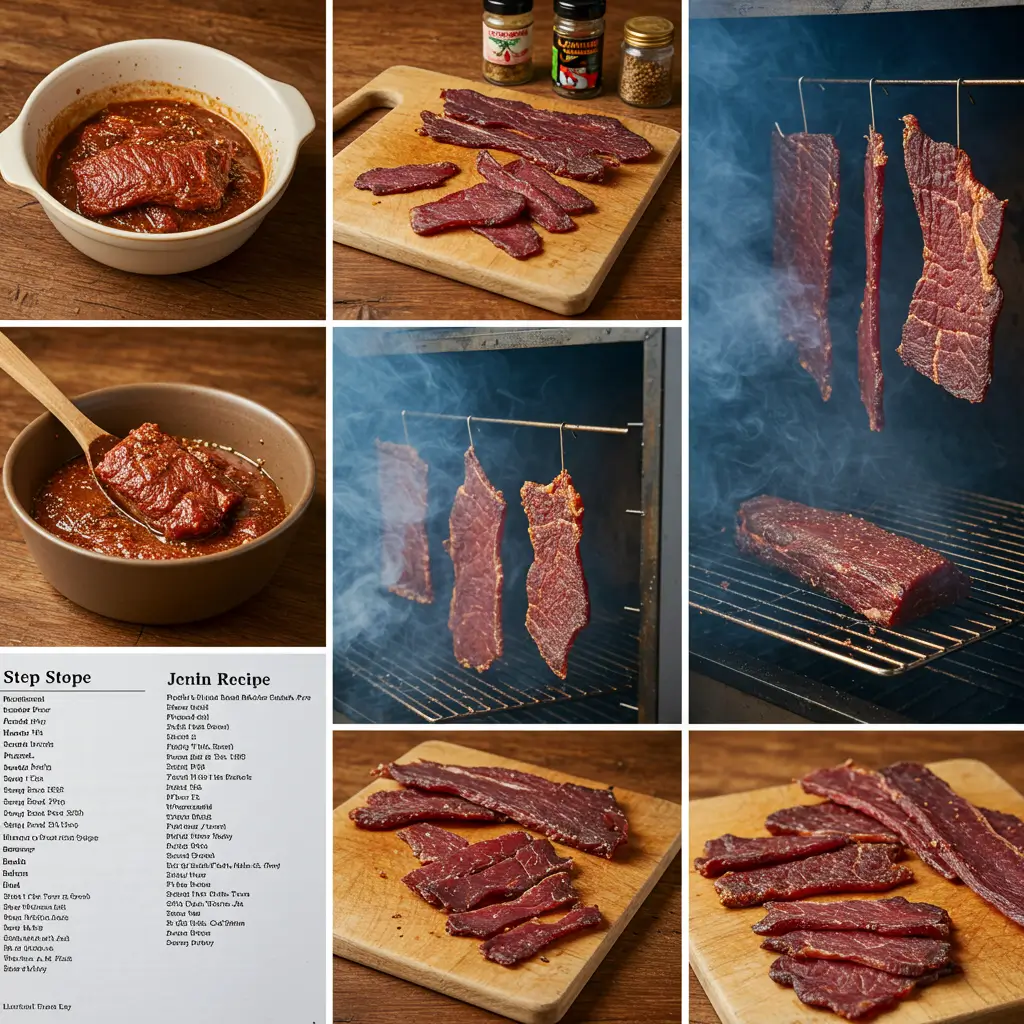
Selecting the Right Meat for Your Smoked Jerky
Making the best smoked jerky begins with picking the right meat. Not all cuts are the same when it comes to making tasty jerky. This jerky will surely impress your loved ones.
Lean meats are key to making great jerky. Beef top round, bottom round, and sirloin tip are top picks for home smokers. These cuts have little fat, making your jerky tender and full of flavor.
- Beef: Top choices for best smoked jerky
- Venison: Lean and packed with wild game flavor
- Turkey breast: Low-fat alternative for health-conscious jerky lovers
- Chicken: Another lean protein option
Fat content is very important in making jerky. Too much fat can cause spoilage and shorten shelf life. Experts say to trim visible fat before slicing and marinating.
| Meat Type | Fat Content | Flavor Profile |
|---|---|---|
| Beef Sirloin | Low (3-5%) | Rich, Classic |
| Venison | Very Low (1-2%) | Gamey, Intense |
| Turkey Breast | Ultra Low (1%) | Mild, Lean |
When picking meat for your jerky, think about thickness and grain. Choose cuts that are 1/4 to 1/2 inch thick. Slice against the grain for the tenderest jerky.
Essential Equipment and Tools for Perfect Smoked Jerky
Making delicious smoked jerky needs more than just meat and spices. Professional jerky makers know that the right tools are key. They help achieve flavors as good as barbecue chicken or roasted chicken.
Choosing the right tools can elevate your jerky from good to great. Home cooks and smoking fans need a full set of gear. This ensures safety, precision, and amazing taste.
Must-Have Smoking Accessories
- High-quality digital meat smoker
- Sturdy cutting board with non-slip surface
- Sharp slicing knife
- Meat slicer for consistent thickness
- Wire cooling racks
- Food-grade dehydrator trays
Safety Equipment Checklist
- Heat-resistant gloves
- Long-handled tongs
- Fire extinguisher
- Protective eyewear
- Kitchen apron
Temperature Monitoring Devices
Keeping the temperature just right is vital when smoking meats. Professional-grade digital thermometers with multiple probes are essential. They track both meat and smoker temperatures accurately.
- Instant-read digital thermometer
- Wireless remote temperature monitor
- Smoker-specific thermometer
- Infrared surface temperature gun
Investing in quality equipment makes your jerky-making journey from amateur to pro. It ensures delicious results every time.
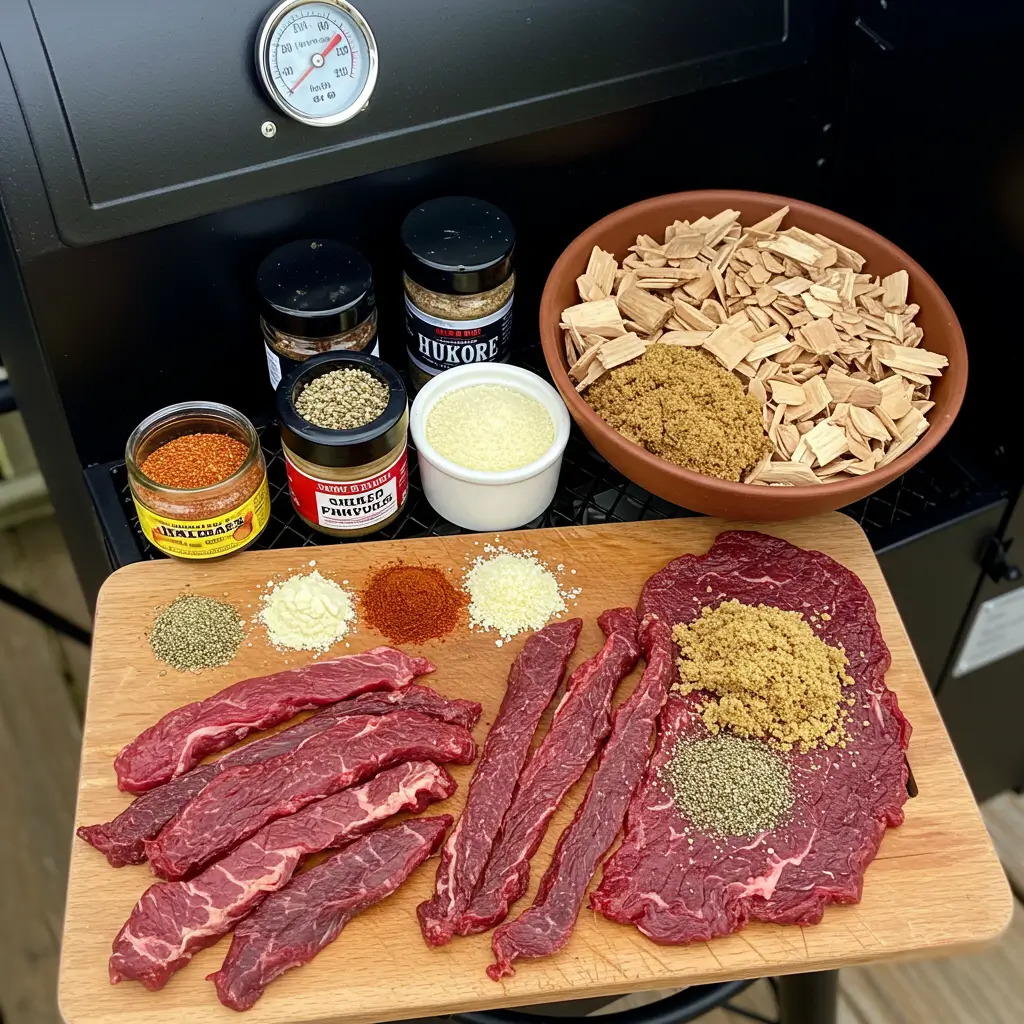
Preparing Your Meat for the Perfect Jerky Texture
Making great jerky begins with careful meat preparation. Unlike regular poultry dishes, jerky needs special cutting and trimming. This is key to getting the right texture. Experts in jerky know that choosing and preparing the meat is essential for tasty chicken recipes and other jerky types.
Here are the main steps for preparing meat for jerky:
- Choose lean cuts with little fat
- Remove visible fat and connective tissues
- Cut meat against the grain for tenderness
- Go for 1/4-inch thick slices consistently
Meat tenderizing is vital in making jerky. Freezing meat partially before cutting helps get even slices. This method is great for chicken and other lean proteins. Use a sharp knife or meat slicer for precise cuts.
- Pick high-quality meat from reliable butchers
- Keep meat cold while preparing
- Use sharp tools for cutting
- Ensure all slices are the same thickness
By sticking to these steps, you can turn regular meat into delicious jerky. This jerky will be as good as any professional dish. The right preparation leads to a tasty and consistent result every time.
Creating the Ultimate Jerky Marinade
Making the perfect marinade turns regular meat into amazing jerky. Your marinade is key to rich flavors that make jerky hard to resist. It works for beef, turkey, or even chicken-inspired jerky, making your meat preservation better.
Marinades are more than just flavor boosters – they’re an art. They need careful balance and creativity. Professional jerky makers know the secret is in mixing ingredients that go deep into the meat.
Classic Marinade Foundation
A good marinade has:
- Salty base (soy sauce or Worcestershire sauce)
- Acidic part (vinegar or citrus juice)
- Sweet part (brown sugar or honey)
- Spices and herbs for depth
Flavor Combination Strategies
Try spice mixes like grilled chicken marinades. Mix:
- Smoky paprika
- Garlic powder
- Red pepper flakes
- Dried herbs like thyme
Marinating Techniques
Marinating well needs focus. Always refrigerate while marinating and let it rest for 6-24 hours. Use a non-reactive container and make sure the meat is fully covered for best flavor.
The secret to great jerky is patience and precision in making your marinade. Each ingredient adds to a complex flavor that will make your homemade jerky unforgettable.
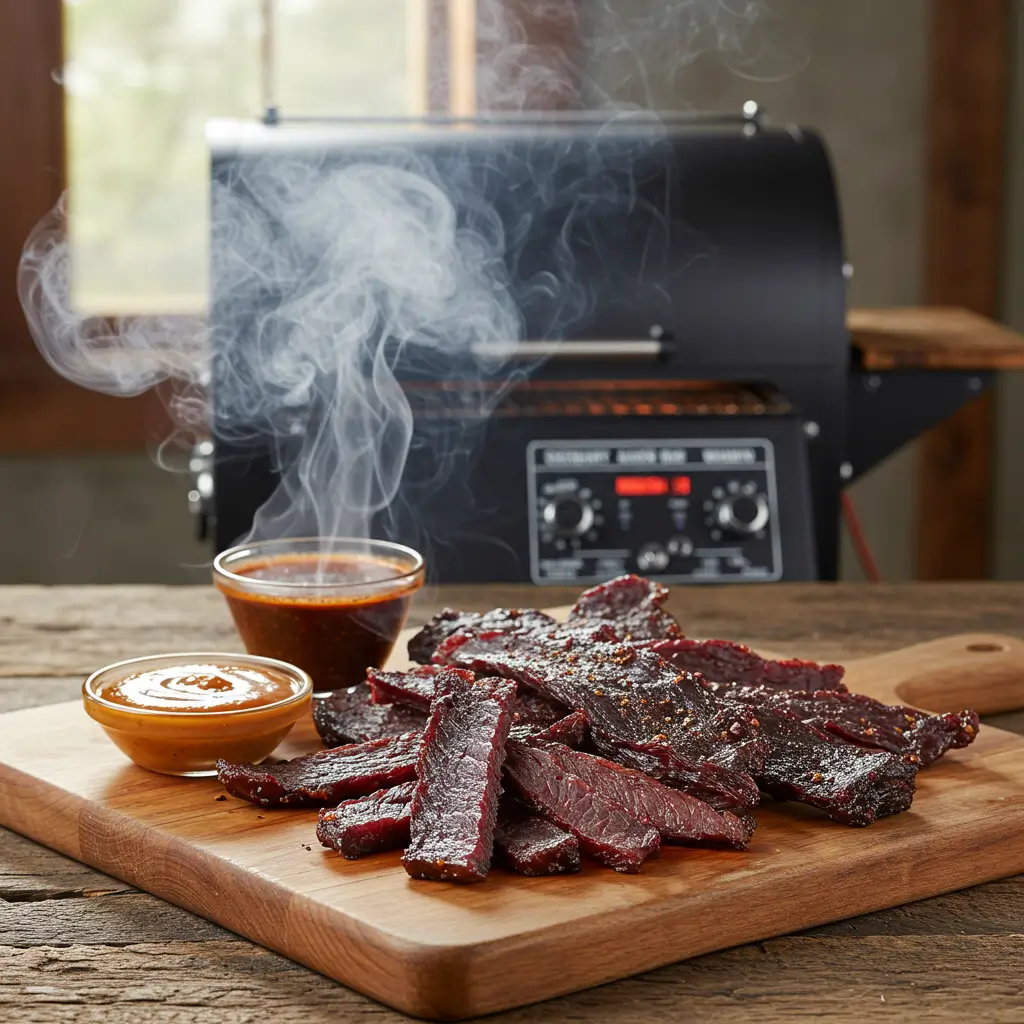
Simple Smoked Jerky Recipe Smoker Guide
Making delicious smoked jerky at home is simpler than you might think. While many try smoked chicken breasts, jerky needs a different method. This guide will show you a simple recipe to make tasty jerky.
- 2 pounds of lean beef (top round or sirloin tip)
- 1/4 cup soy sauce
- 2 tablespoons worcestershire sauce
- 1 tablespoon brown sugar
- 1 teaspoon black pepper
- 1 teaspoon garlic powder
Getting ready for jerky is important. Start by removing all visible fat from the meat. This prevents spoilage during smoking. Then, cut the meat into thin strips, about 1/4 inch thick, against the grain for tenderness.
Marinating the meat makes it flavorful. Mix your marinade ingredients in a bowl. Then, soak the meat strips completely. Refrigerate for 6-8 hours to let the flavors soak in.
Smoking jerky is different from smoking chicken. Keep the temperature low, around 165°F (74°C), to dry the meat without overcooking. Use applewood or hickory chips for a smoky taste that goes well with the marinade.
Smoke the marinated strips for 4-6 hours, turning them now and then. The jerky is done when it bends without breaking and looks rich and deep. Let it cool fully before storing it in an airtight container.
Smoking Techniques and Temperature Control
Mastering smoking techniques is key to making delicious smoked jerky. It’s all about precision and knowledge. This turns simple meat into a tasty treat.
Creating perfect smoked jerky means knowing how to control temperature and smoke. A smoker is more than a cooking tool. It’s a way to make your jerky truly special.
Wood Selection for Optimal Flavor
Choosing the right wood is vital for the taste of your smoked jerky. Each wood type gives a unique flavor:
- Hickory: Strong, bacon-like flavor perfect for beef jerky
- Apple: Mild, sweet taste ideal for poultry and pork
- Mesquite: Intense, earthy flavor best used sparingly
- Cherry: Subtle, fruity notes that complement most meats
Smoke Management Tips
Managing smoke is important to avoid bitter flavors in your jerky. Here are some tips:
- Use dry, seasoned wood chips
- Maintain consistent smoke levels
- Avoid dense, thick smoke
- Monitor smoke color – thin blue smoke is ideal
Experienced jerky makers see smoke control as an art. The aim is to boost, not mask, the meat’s natural taste during smoking.
Common Mistakes to Avoid When Smoking Jerky
Making the best smoked jerky needs skill and focus. Many beginners make big mistakes that can mess up their jerky. Knowing these common errors will help you make delicious, top-quality smoked jerky every time.
Getting the meat ready is key for great jerky. Novice smokers often make these big mistakes:
- Inconsistent meat thickness – Uneven cuts lead to uneven drying
- Skipping the trimming process – Excess fat can spoil the jerky quickly
- Neglecting proper meat slicing techniques
Keeping the temperature right is another big challenge. A steady smoking temperature is key to avoid food safety risks and get the right texture.
- Fluctuating smoker temperatures can create unsafe meat conditions
- Incorrect heat levels result in tough or undercooked jerky
- Ignoring recommended smoking temperatures
Seasoning and marinating need to be done with care. The best smoked jerky comes from careful flavor development and salt balance. Common seasoning mistakes include:
- Over-salting which makes jerky too harsh
- Under-seasoning that produces bland results
- Not allowing sufficient marinating time
By avoiding these big errors, you’ll greatly improve your smoked jerky quality. You’ll make professional-level results every time.
Storage and Preservation Methods
Making tasty smoked recipes needs careful storage and preservation. The right steps keep your homemade jerky safe and delicious for months. Knowing how to handle it ensures your jerky stays good and avoids safety problems.
Proper Packaging Techniques
Effective packaging is key to keeping smoked jerky fresh. Here are the main steps:
- Use vacuum-sealed bags to remove air and prevent moisture
- Select food-grade airtight containers for short-term storage
- Allow jerky to cool completely before packaging
- Use clean, dry hands or utensils when handling
Shelf Life Guidelines
Storage methods affect how long your jerky lasts. Room temperature storage usually keeps it fresh for 1-2 weeks. Refrigerated jerky can last 3-6 months, and frozen jerky stays good for up to a year.
“The secret to great jerky is not just in making it, but in preserving its flavor and texture.” – Jerky Preservation Expert
By sticking to these storage tips, you’ll enjoy your homemade smoked recipes for longer. Proper preservation is the last step to making perfect jerky that tastes great and stays fresh.
Troubleshooting Your Smoked Jerky Problems
Making perfect smoked jerky is a skill that takes time to master. Even those who have been doing it for years can run into problems. Knowing what these issues are can help you get better at making tasty jerky every time.
Many jerky makers face common problems that can affect the quality of their meat. Let’s look at the most common issues and how to fix them:
- Overly Dry JerkyReduce smoking time
- Lower temperature settings
- Check meat thickness
- Too Moist JerkyIncrease drying time
- Ensure proper air circulation in smoker
- Pat meat dry before smoking
Keeping the temperature right is key when smoking jerky. If the heat is not steady, your jerky might not turn out right and could even be unsafe to eat.
| Problem | Possible Cause | Solution |
|---|---|---|
| Bland Flavor | Insufficient Seasoning | Adjust marinade recipe |
| Tough Texture | Overcooking | Reduce smoking time |
| Uneven Drying | Inconsistent Meat Thickness | Slice meat uniformly |
Experts say keeping a detailed log of your smoking process is a good idea. Note down the temperature, time, type of meat, and seasonings used. This can help you spot and fix problems fast.
Pro Tip: Practice makes perfect in smoked jerky preparation!
By knowing about these common problems, you’ll get better at making delicious smoked jerky. Your family and friends will love it.
Conclusion
Learning to make smoked jerky is a fun journey. It mixes skill, creativity, and tasty flavors. Whether you’re new or have experience, making jerky at home is full of chances to try new things and enjoy the process.
The secret to great smoked jerky is knowing the basics. This includes picking good meat, making the right marinade, keeping the smoker at the right temperature, and storing it correctly. Every batch you make helps you get better and find flavors you like.
Getting good at making smoked jerky takes time and effort. Don’t worry if your first tries aren’t perfect. Every attempt helps you improve, learn about your equipment, and appreciate the art of making jerky.
Enjoy the journey, share your jerky with others, and keep trying new things. Your homemade smoked jerky will be a tasty treat. It will also show off your creativity and hard work in mastering this old method of preserving food.
FAQ
Have You Tried This Recipes!
There are no reviews yet. Be the first one to write one.

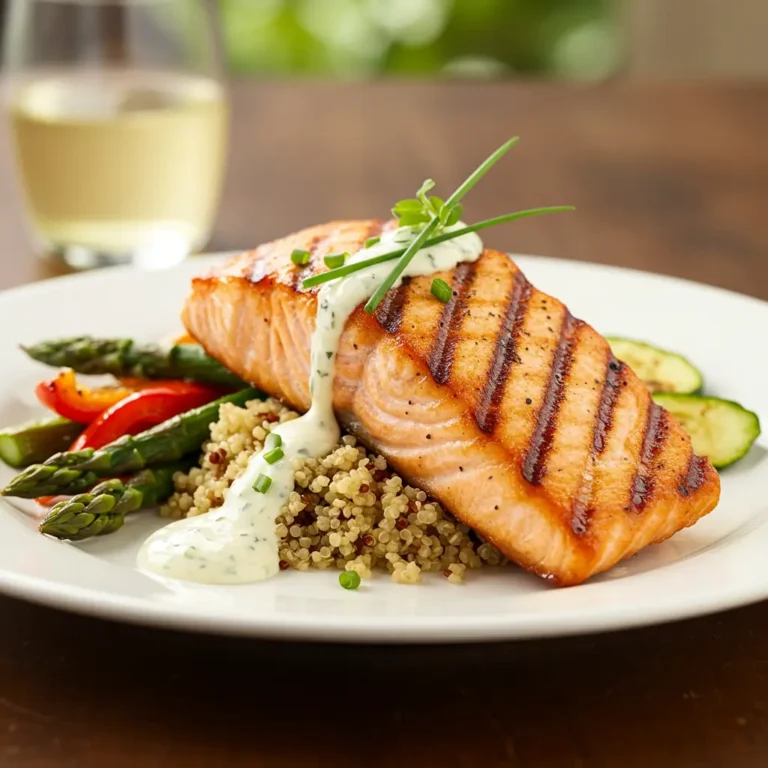
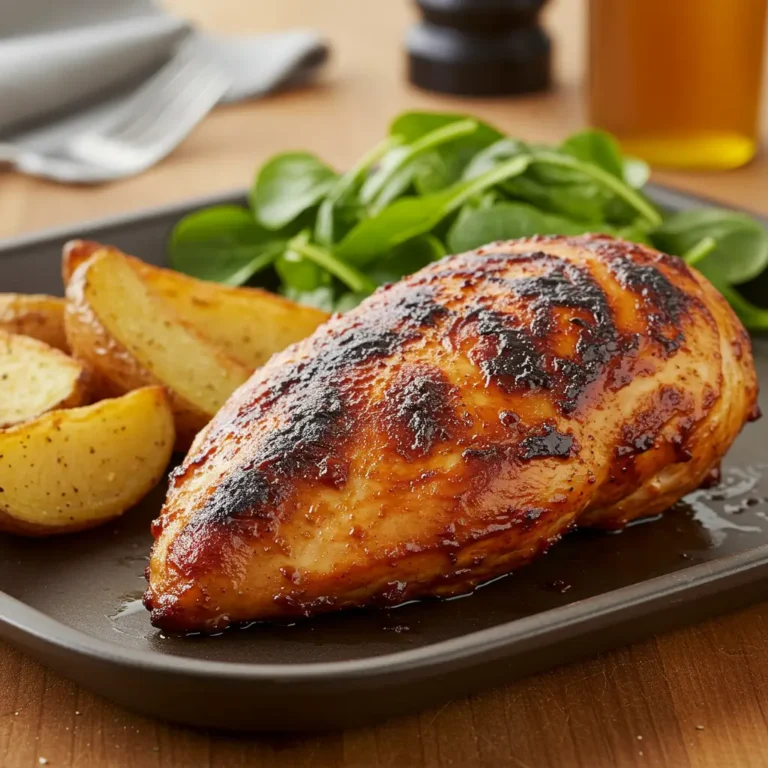
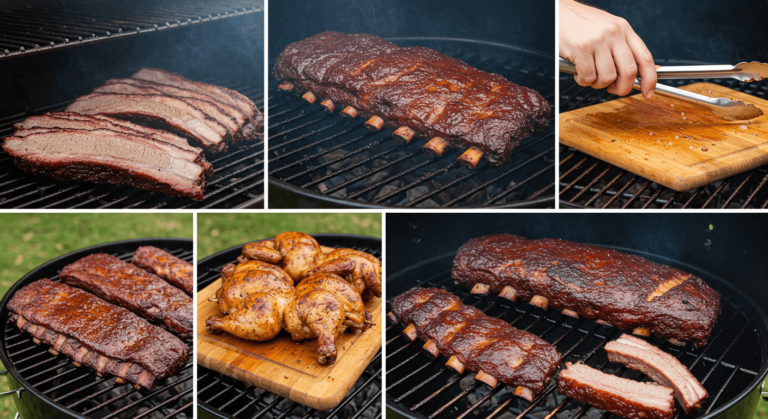
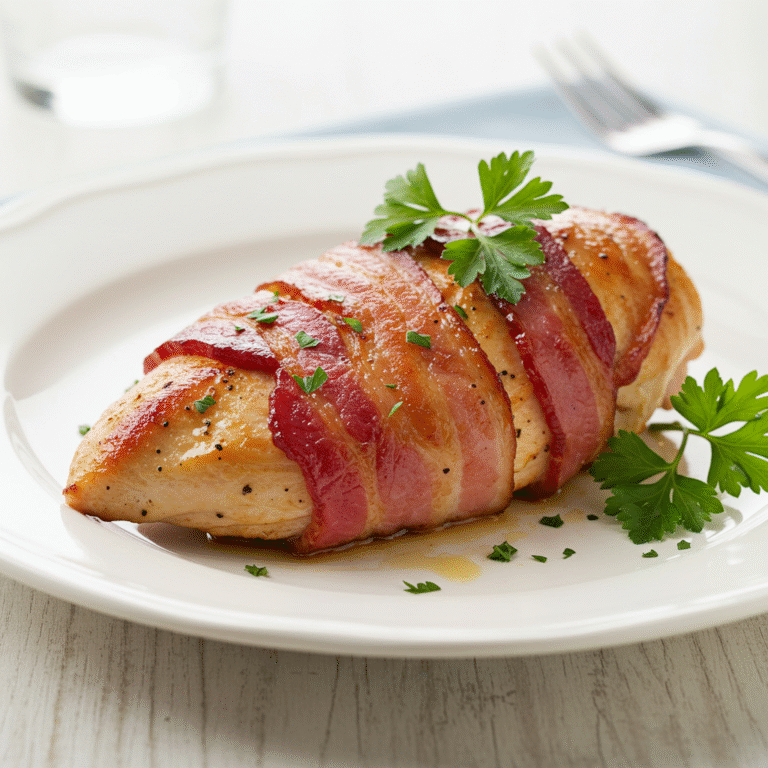
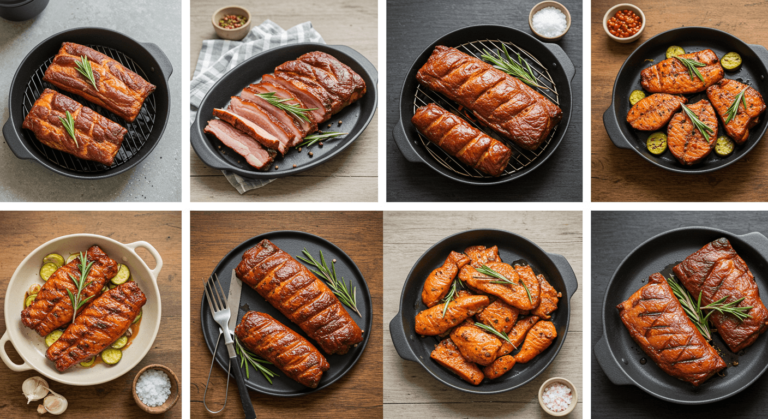
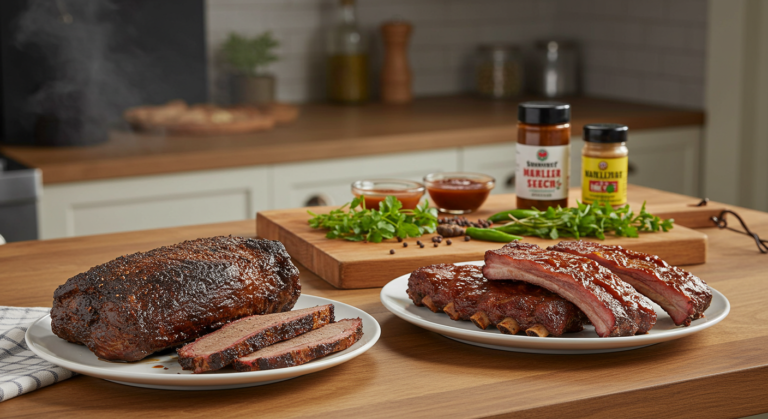
Leave a Reply